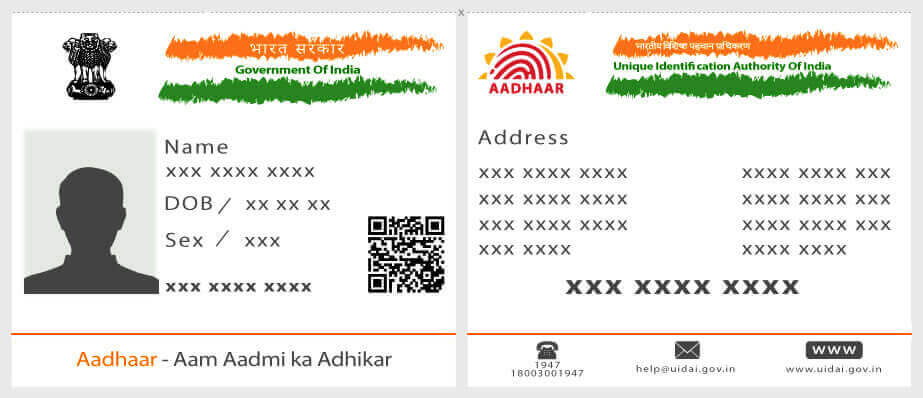Aadhaar is a one-time issued identity card by the Indian government. This document is unique to an individual and assigned to every Indian resident citizen. There is no fee charged to apply for this document. An Aadhaar number contains 12 digits. These are random numbers that keep a record of a person’s demographic and biometric data. It was in 2016, when the UIDAI (Unique Identification Authority of India), constituted the Aadhaar program.
It is the UIDAI that issues every Aadhaar card. It collects the biometric and demographic data of an individual and keeps a record of the same. The Aadhaar information is used to provide citizens with certain government subsidies and benefits through a transparent and streamlined method.

As Aadhaar Card is a government-recognized document, people can use it as a proof of address and proof of identity. It can be used to open a bank account, apply for a loan, avail government subsidies, etc.
The document consists of the following details:
The eligibility criteria of Aadhaar card is mentioned below:
The aadhaar card application process is completed at any of the authorized aadhaar enrolment centre or permanent enrolment centre. visit the official website of uidai to find an updated list of the enrolment centres. uidai has authorized more than 10,000 bank branches and post offices as permanent enrolment centres. an individual can complete the enrolment process by following the mentioned steps
If an applicant does not have the necessary documents, then he/she can follow the below-mentioned arrangement by the UIDAI:
If the applicant is a minor, and below the age of 5, then the application process is as follows:
An applicant who wishes to track or check status of Aadhaar application online can visit the official UIDAI website. The applicant has to provide his/her enrolment ID, mentioned on the acknowledgement slip issued after the submission of the application, to get the application status update.
There is a facility by UIDAI for the storage and retrieval of Aadhaar details, electronically. This is known as the e-Aadhaar. This document is available in PDF format. One can download it from the website of UIDAI. An individual can access his/her e-Aadhaar from UIDAI official website by using any of the following ways:
Here is a brief summary of different services made available for Aadhaar:
1. Verification of Email or Mobile Number Registered with Aadhaar It is advisable to provide an accurate and valid mobile number or email address when applying for an Aadhaar card. This helps in receiving updates and accesses to certain services. By enabling mobile number and email address with this document, one can receive information about Aadhaar and notifications, remotely.
2. Verification of Aadhaar Number One can verify if their Aadhaar card has been deactivated or active by following the mentioned steps:
3. Check Status of Aadhaar Linking
To access government schemes and subsidies, the applicant must link his/her bank account with Aadhaar card to ensure disbursement of the subsidy. One can check the status of the linking process by visiting UIDAI’s website, and navigating to ‘My Aadhaar’ tab.
4. Retrieval of Aadhaar Number
If a person has lost or misplaced Aadhaar Card, then he/she can retrieve the same. One can retrieve his/her VID, EID, or Aadhaar card electronically. To retrieve this information it is mandatory have a registered mobile number updated with Aadhaar.
5. Lock or Unlock Biometrics
The Aadhaar card contains the holder’s biometric and demographic details. This information is useful to authenticate the person’s identity when he/she wishes to avail certain services. There is a chance of misuse of information when sharing Aadhaar information with a merchant or vendor for verification. Thus, to ensure security of the data, UIDAI allows the card holder to lock access to biometric data. The data can be unlocked at the discretion of the card holder.
6. Generation of VID (Virtual ID)
UIDAI has initiated Virtual ID to protect the information provided under Aadhaar. The VID gives limited access to KYC to merchants and vendors that ask for Aadhaar information for different services.
7. Verification of Aadhaar Offline
Aadhaar paperless e-KYC is a secure document that one can share for offline verification of Aadhaar identification. The document holder can share it as a proof of address or identity in a secure manner. The data is available in tamper-proof format for the service providers and vendors. Generation of Aadhaar paperless offline e-KYC is done in the following way:
Every time a person submits his/her Aadhaar card for a purpose, the information of the AUA (Authorized User Agency) accessing the details gets logged onto the Aadhaar system. One can check this authentication history of the AUA and the data it has accessed. By doing so, one can verify who access their Aadhaar data. Thus, the feature of checking authentication history helps to manage the security of the information.